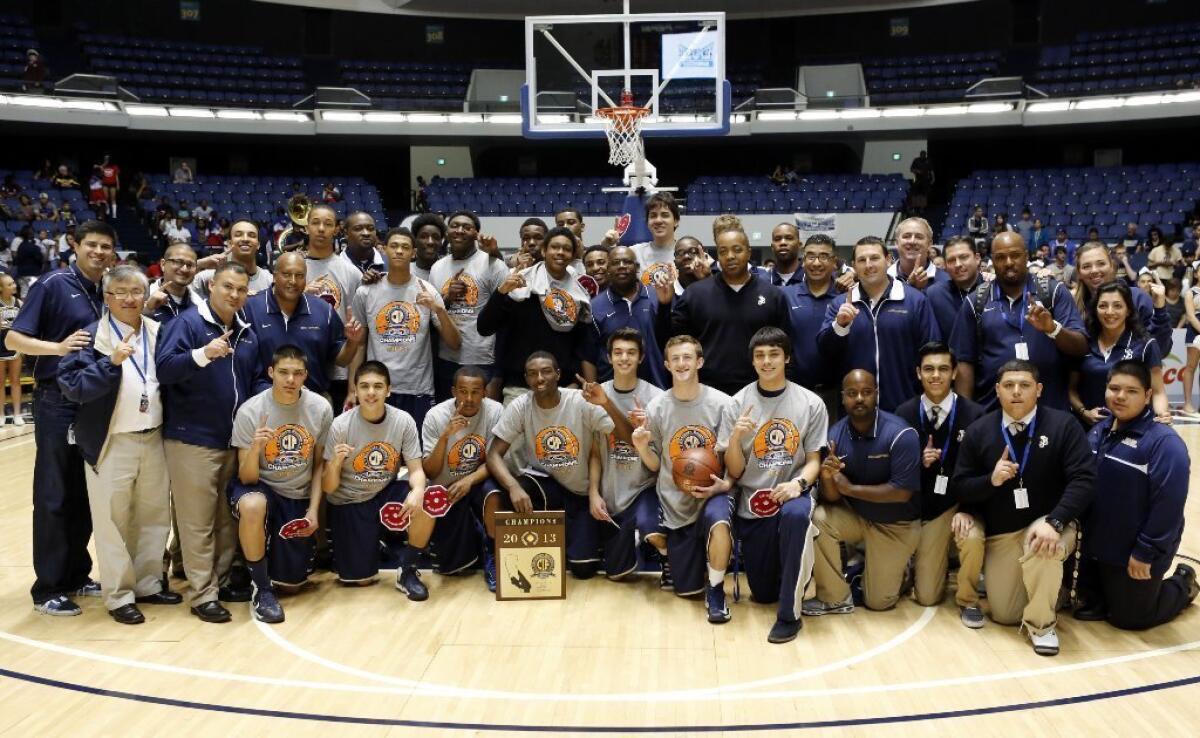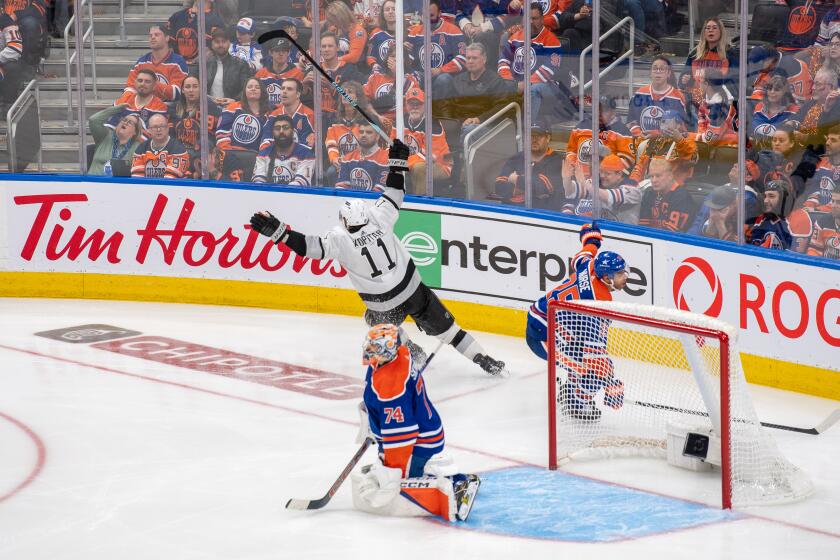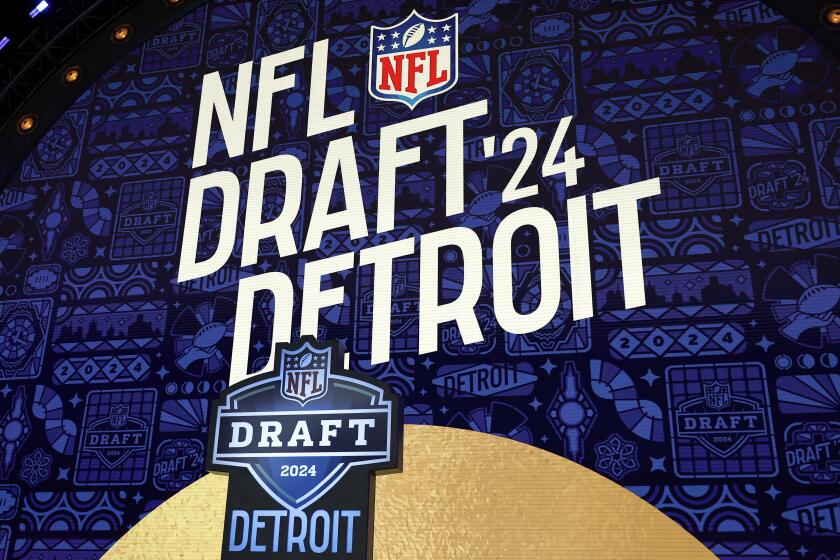Transfers are a key to success in marquee high school sports

For decades, high school sports programs in Southern California relied on a simple formula: teenagers in the neighborhood would show up as freshmen or sophomores, try out for a team and stick together through graduation, succeeding or failing with lifelong friends at their side.
Times have changed. To win a championship at the highest level in the high-profile sports — football and basketball — you clearly need a transfer student or two.
Every team that won a football or basketball championship last season in the top division of the Southern Section or City Section had transfer students playing important roles. It’s a trend that began to accelerate in the last decade.
From Long Beach Poly winning the Pac-5 Division in football to Harbor City Narbonne winning the City Division I title, to Westchester winning the City Division I title in basketball to Etiwanda taking the 1AA title, transfers were prominent. At the state basketball championships, Santa Ana Mater Dei (Open), Santa Monica (Division I), Redondo (Division 2) and Pacific Hills (Division 4) all relied on students who showed up sometime after their freshman year.
Bellflower St. John Bosco won the Division 3A basketball championship with a starting lineup of transfer students. And it’s not just in football and basketball that transfers are making a huge impact. Gardena Serra won its first Division 3 baseball championship with the help of six transfer students.
Last school year was the first in which a new state transfer rule reduced the sit-out period from one year to one month for students who switch schools without moving. There were 14,918 transfers statewide, according to statistics compiled by the CIF, and there’s no sign that number is going to decrease in 2013-14 now that everyone knows how the rule works.
Player movement is being fueled by a lack of loyalty and changes to NCAA recruiting rules that increase the importance of travel ball competition.. At some private schools, presidents and principals have become sports-team general managers, deciding who gets in and who receives financial aid. Parents have been empowered to shop around for the best deal.
Private schools have an option whether to accept or reject any student, and many have adopted the philosophy that welcoming athletes looking to transfer can be a boon. Exposure generated by the sports teams fills classroom seats, the thinking goes. Public schools, which receive state funds based on their enrollment, are equally eager to add students.
The summer has become, as described by one basketball coach, “the wild, wild West,” where rosters are in constant flux and coaches, athletes and fans wait to see who’s coming, who’s going and what’s the latest rumor.
It’s a remarkable change from the days when coaches knew in June who would be arriving in September just by visiting their local junior high schools or parish schools or by learning about a younger sibling from a brother or sister.
Now, there are no guarantees. Summer is a time when deals are made, relationships can change and the wooing and selling of programs enters high gear.
There’s at least one private school — Los Angeles Loyola — that continues to rely mostly on the old formula, where students arrive as freshmen and stay for four years.
The all-boys school has won five consecutive Commissioner’s Cups recognizing it as the top athletic program in the Southern Section.
“I rely on our freshman class every year,” said volleyball Coach Michael Boehle, who has won five section titles and had one transfer student in 15 years. “We’re blessed to get the kind of kids who want to come here for the academics and extracurricular activities.”
But Loyola has not won a championship in football since 2005 and has never won a 1AA championship in basketball. Because transfers have become a key ingredient in success at the highest levels in those marquee sports, it will be interesting to see whether the Cubs begin to participate in a transfer game that opponents have embraced.
What do transfers offer? They help programs avoid rebuilding years. They fill holes left by graduating seniors. They add immediate depth, especially when a senior shows up with previous varsity experience.
What’s wrong with transfers? They help schools form virtual all-star teams, which goes against what high school sports is supposed to be about. They take away spots from players who sometimes have spent two years waiting for the chance to start. They sometimes arrive with promises and expectations that can lead to internal conflicts.
In convincing Southern Section schools to support the new transfer rule, Commissioner Rob Wigod promised to intervene when schools became the destination for an unusual amount of transfers. Last month, Upland’s football team had three players declared ineligible after a joint Southern Section and district investigation into 13 transfer students.
Of course, the Southern Section doesn’t have the resources to conduct complicated investigations. And the new transfer rule was designed to manage transfers rather than to discourage them, Wigod said.
It seems clear the increasing number of transfers is disruptive, creates an environment of distrust and is leading to disillusionment with the ideals and aspirations of the high school sports experience.
This month, a group of Orange County basketball coaches met to kick around ideas about dealing with the transfer issue. Among the suggestions: Limit the number of assistant coaches; bar high school coaches from coaching travel ball; reinstate the Association rule that prevented coaches from coaching players in the off season; educate administrators better on what constitutes undue influence; lengthen the sit-out period.
The debate isn’t going away, but the facts are facts. Transfers are helping teams win championships, and top neighborhood teams are a blast from the past.
More to Read
Get our high school sports newsletter
Prep Rally is devoted to the SoCal high school sports experience, bringing you scores, stories and a behind-the-scenes look at what makes prep sports so popular.
You may occasionally receive promotional content from the Los Angeles Times.







